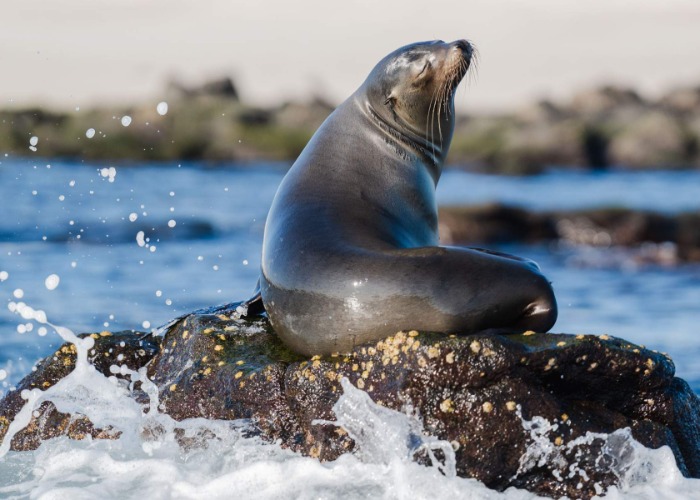
On Hurtigruten's new Galapagos islands small-ship expedition cruise, Jo Kessel sees the Big Fifteen, learns fascinating facts about wildlife from the ship experts, and returns transformed, with a newfound appreciation for nature.
Every great adventure begins with a ‘moment’ and mine comes at a local market in Quito, Ecuador. Some stalls sell fruit and veg; others sell healing. I hand five dollars to a female shaman who swats my body with a herbal bouquet and then stills it over my heart. “Better?” she asks. Bizarrely I DO feel better.
I’m on an expedition cruise to the Galapagos, a remote Ecuadorean archipelago 621 miles (1,000km) from the mainland. It’s famous for its wildlife and for being where Charles Darwin developed his theory of evolution. And because there are no direct international flights there, our expedition started in the country’s capital.

Culture fix
The word ‘expedition’ conjures a sense of adventure, which is exactly what Norwegian cruise line Hurtigruten promises to deliver on its new 10-day Galapagos itinerary. There are 28 of us in our group – a mix of Brits, Americans, Germans and Norwegians. Our pre-cruise stay introduces us to Quito’s colonial, historic centre which, at 9,186 feet (2,800m), is the world’s second highest capital. It’s surrounded by volcanoes, many of them active, with Cotopaxi the showstopper.
Cotopaxi last erupted in 2015 and its snow-capped summit soars to 19,685 feet (6,000m). The next day we hike around its base where, at 13,123 feet (4,000m), our lungs gasp for oxygen. Not quite ‘expedition’ by Edmund Hillary standards, but it still feels like we’re pushing boundaries.
The Galapagos are a two-hour flight from Quito and aerial views from the plane as we approach show the desolateness of these tropical, volcanic islands – there are thirteen major islands as well as a plethora of smaller isles and islets, only 3% of which are inhabited.
Wildlife first
It's instantly clear that our expedition voyage will be very different to a conventional cruise. Our ship is called the Santa Cruz II and is tiny – it carries 90 passengers – and is waiting for us out at sea. The only way to reach it is on large, inflatable zodiac boats and before getting into one, the expedition team teaches us the ‘Galapagos handshake’ – a way of holding crew members arms to help you step in and out safely.
Cabins are comfortable and have large picture windows, but there won’t be much time spent in them with several stops a day planned and umpteen activities on offer, from hikes to snorkelling and kayaking. Wherever we go, whatever we do, it will always be about the wildlife.
Responsible outlook
Africa has the Big Five; the Galapagos has the Big Fifteen. In every cabin is a book listing the fifteen iconic species found here. We’re encouraged to put a tick next to each one once it’s spotted.
We’re split into small groups of 10, each one accompanied by one of the ship’s expert naturalists. Our first full day goes like this: shortly after sunrise a zodiac takes us to the island of San Cristobal for a hike. A welcome party of Galapagos sea lions greets us on shore: tick. We head inland and see rare red-footed boobies which aren’t found anywhere else on the planet apart from this particular island: tick. Then we see blue-footed boobies: tick. Later that morning we kayak. A sea lion plays alongside our boat, lazing on its back to soak up the sun’s rays. Shortly afterwards a green sea turtle pops its head out the water.
This is another ‘tick’ moment, but it’s also so much more. This is nature at its most wondrous… and closest. Be careful where you tread because every inch teems with extremely well-camouflaged animals.
The UNESCO-protected Galapagos are one of the world’s best examples of responsible tourism. Its strict rules – visitors mustn’t disturb or get too close to the animals – mean the islands look much how they did when Darwin visited in 1835. The group bonds over photography, with everyone keen to snap that dream wildlife shot, whether it’s with an iPhone or a paparazzi-style lens.
Educational experience
Thanks to the naturalists we’re always learning, either on the ground or in lectures onboard. The flightless cormorant spotted later in the week is a prime example of Darwin’s evolution – when they no longer needed to fly to forage, they slowly over time lost power in their wings. “You use it or you lose it,” explains guide Carmen.
Most days have a couple of hours’ downtime when expeditioners can be found chatting over a drink on the ship’s sun deck or in the hot tub. And cuisine is seriously good – creative three-course waiter-served lunches and dinners with an Ecuadorean twist. Think Galapagos bluefin tuna followed by chicken in coffee sauce. Better still, wine and Wi-Fi are included.
Other Big 15 sightings include albatrosses who we watch mating, fur sea lions, hawks, iguanas, frigates and lumbering, giant tortoises, who despite looking slow walk around three miles a day.
“Can anyone guess why these tortoises live up to 200 years?” a guide asks. We shout out possible reasons – their shell; their diet; their size. None are right. Apparently, it’s because they’re patient.
There are exciting non-big 15 sightings too, like sharks, dolphins and a manta ray so ginormous that it shocks us when we catch it back-flipping behind the ship’s wake.
The six-night cruise whizzes by and every day has a pinch-me moment, like snorkelling with green sea turtles and lazing on a white-sand, Robinson Crusoe beach with only sea lions for company. Even more dramatic is when a blue-footed booby dive bombs inches from me while I’m swimming in the sea – unbelievably a fellow passenger captures this on camera.
Transformative journey
In 1859 Darwin altered mankind’s thinking forever when he published his infamous On the Origin of Species book based on his findings from the Galapagos. And something witnessed on our final hike shifts my thinking further. A mother blue-footed booby was trying to feed her chick. Hovering above them was a frigate hell bent on stealing the fish in her beak. I instinctively flapped my arms to shoo the frigate away, but the guide stopped me. “Here we must leave nature to run its course,” she says.
Since time began, nature has been left alone in these enchanted isles and it’s a privilege to witness this first-hand. A Galapagos expedition is no ordinary cruise – it’s a cruise which will leave you changed forever.
Getting there
A 10-day Hurtigruten expedition cruise to the Galapagos islands on MS Santa Cruz II costs from £7,721pp, full board. Price includes return flights. For more info visit hurtigruten.com/en-gb/expeditions
Main image: Andres Mesias